
Disclaimer: This blog entry wasn’t written until seven years after the trip. It should be noted that this was a huge mistake. Sometimes after writing so much about other days, it happens that at the time directly after the trip or even during, I convince myself that the details are not that important. Years later, these details are that important, and pulling them out of foggy memories is difficult. The photos help and often leave clues, and then Caroline’s memories are usually far clearer than mine. With that said, here goes.
Rothenburg ob der Tauber is the full name of this town and with 52 images accompanying this blog entry, this promises to be a full-on slog to get to the end. Looking down to the bottom, I see the spaghetti ice cream, and I’d like to just jump to it and tell you how yummy it was, but there were all these things we saw along the way that I need to make note of, so we can better cement the experience in our memories.

While I’d been here in Rothenburg years before I met Caroline, and she’d been here as a student, we were too young to appreciate things beyond their surface. Now, when we glance at things superficially, we do so with intent and pretend we are taking in some deeper meaning. Of course, we had to step up on the village defensive wall because being old means we have had to move beyond just getting some food and souvenirs to say we’ve been here. Honestly, though I don’t think we were ever really blasé about our encounters with history, maybe it sounds better to say we were normal young adults non-plussed by things we now find interesting. To admit more than a glancing interest in “old” stuff back when we were young only made us look nerdier than both of us already were. I’m sure everyone around us already knew the level of our social discomfort brought on by our sense of being different, but we needed to believe we were just as disaffected and cool as the cool and disaffected people we loved to hate.

Now we walk into the living landscape of history writ large on the tapestry of time, and we ogle it all with a sense of ooh and aah that is unreservedly laden with geekiness of nerds who really are trying to know as much as possible. We need the impressions splayed across contrasting layers of the environment to sear their geometry and colors deep within our minds so our dreams come alive out of the pages of history instead of out of the ring of the UFC or from the track of NASCAR.

And then you encounter this nightmare fodder and realize that your hopes for consuming more nerd food were just fed a giant heaping of uncertainty. Maybe you won’t escape the demons with tentacles and the moon-faced characters with serpents extruding from their mouths in some medieval old village where plague-addled whores drag their Jack The Ripper-torn limbs through shit-clogged streets offering you favors.

This house was made of gingerbread, I swear.

Somehow I fail to see this as being quite as idyllic as I might have hoped for, as where are the gun-toting open-carry enthusiasts strolling about while some guys wearing their colors were set up at a bench selling meth. Oh yeah, this isn’t Dallas, Texas.

Why is it that civility goes hand-in-hand with a scene like this and the idea of a trailer park being down the hill is anathema to me wanting to be here? Come to think about it, have I ever seen a trailer park in Germany?

This fairytale village is not really a fairytale place at all but is simply a place with a ton of history where average, everyday, common people live and work. It is those of us who visit quaint and beautiful places that label them and give them greater value than the places we come from that might be devoid of character and community.
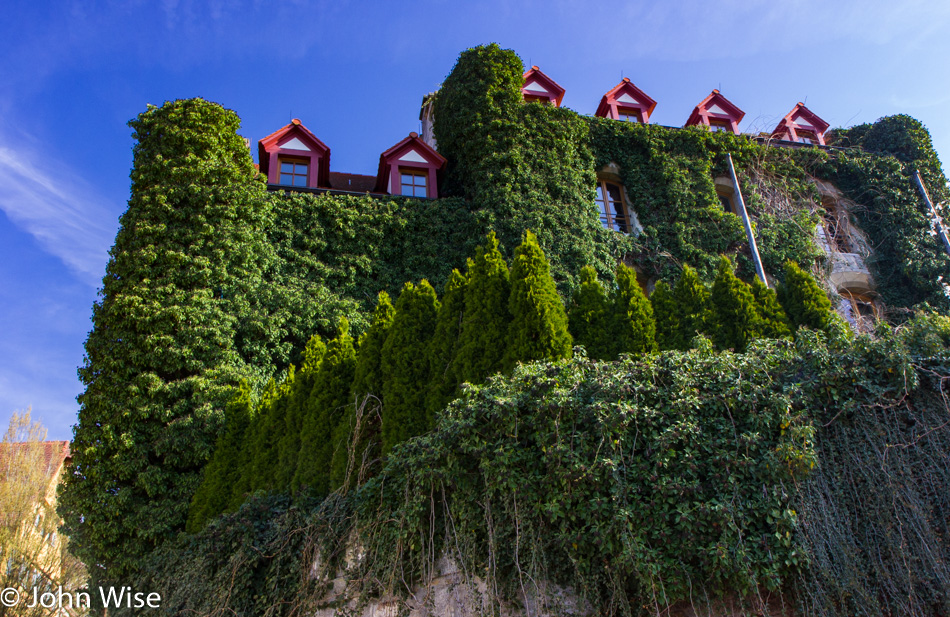
You might see something like this in the Hamptons of New York with an eight-figure price tag, but you’d never see this on the south side of Cincinnati. Why is it that Europeans appear to care more about the quality of life that can be had in places that maintain the environment compared to their counterparts in North America?

You will not find any neon in Rothenburg or any garish billboards. There is nobody standing somewhere spinning signs to attract passersby who might be enticed by a homeless person dancing in the sun while flipping the sign around like a cheerleader in 10th grade twirling a baton. Sure, the history of this village coats everything here, including the air, while the closest thing we have in the States is Colonial Williamsburg, but Rothenburg is not an isolated place. There are many quaint and beautiful villages dotted across the European landscape. Back home, I can’t help but think we have a throw-away history where those beautiful small towns across Texas with great squares and incredible historic city halls are left to decay and give way to burgeoning outlet stores and big-box franchises that replace the old with little concern to what is lost. These signs in Rothenburg are enchanting due to their uniqueness; they are not thrown away for the sake of modernity.

If you’ve ever seen a travel brochure for Germany, you’ve seen a much better photograph of this exact scene than what I was able to photograph today. Heck, if you’ve seen a travel brochure, you’re likely old like me and simply wish that someday you, too, can go stand in places that held so much curiosity when you were a kid.
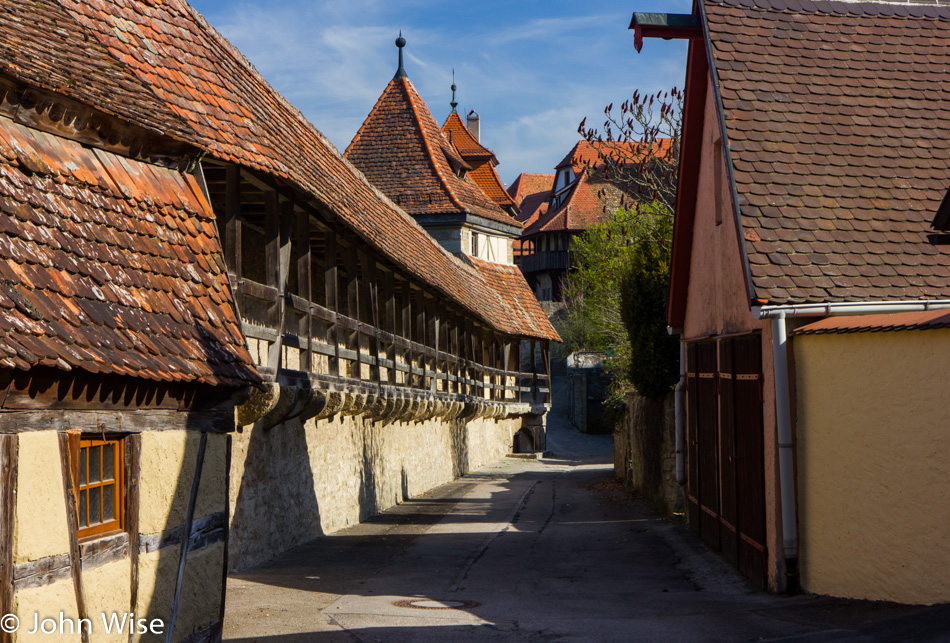
Come to think of it, my curiosity is still that of my childhood. I want to look into the window on the left, walk on this part of the wall at night while carrying a lantern, and investigate what treasures are hidden in the attics long abandoned in some of these homes. What I don’t want to happen is to run into Armin Meiwes up an alley here. Who was Armin, you must surely be asking? He was the guy who ate a dick right here in this village. I’ll bet a dollar Rothenburg hates this connection to their beautiful little hamlet, but that’s just the way it goes when you cultivate an environment of dick eaters among the locals. I’ve heard that 2001 was a good year for cannibalism, but I can’t affirm that from any kind of first-hand experience. Armin is still in prison, and there was a documentary about him, should anyone have a greater curiosity about what dick tastes like.
Edit on April 2, 2021: Rather than hide my stupidity, I have to confess that Rothenburg ob der Tauber is not Rotenburg an der Fulda, where Meiwes was from, so I got the above all wrong. Except for the part where he eats dicks.
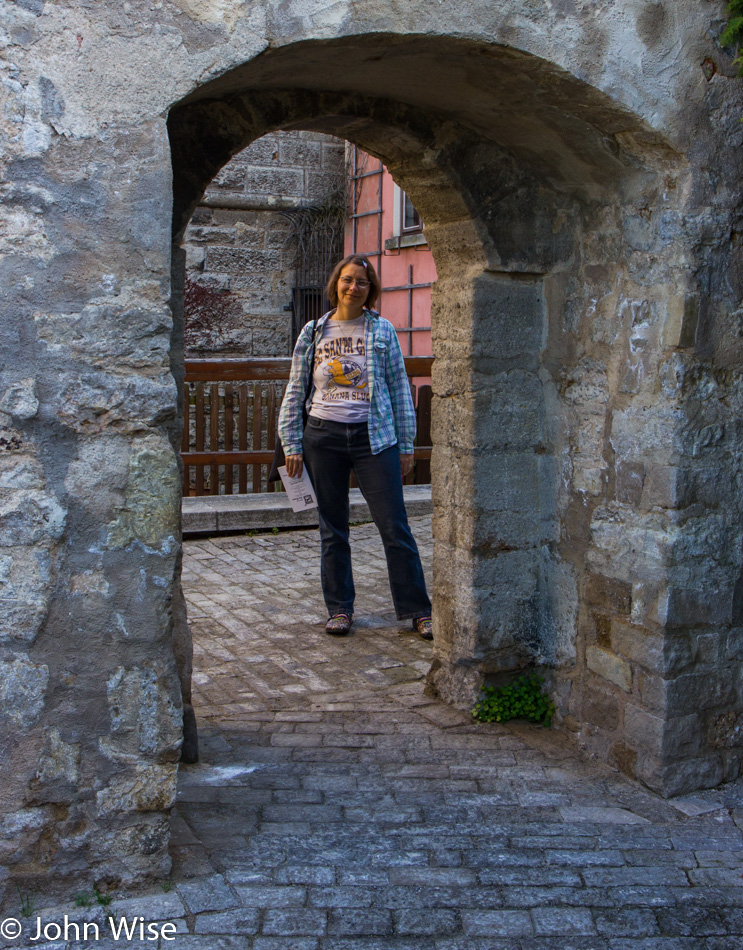
Just then, Caroline barks at me to get moving and stop trying to find signs of cannibalism.

A snail riding a winged snail isn’t something you see every day but then what is it when you are on a road trip from America and you find such a thing in some small corner of Europe?

I thought this spiral stairway leading to the upper floors was pretty cool.

Visiting somewhere wouldn’t be complete without us dipping into a church, and this one here called St. James Church will do just fine.

This hand carving of a symbolic boat to heaven is from a partner church down in Tanzania.

The Holy Blood altarpiece carved between 1500 and 1505 by Tilman Riemenschneider kind of makes me think about Til from Rammstein. My wife just groaned when she read that, but probably not as much as she wondered why in the world I had to write about Herr Dr. Armin Meiwes, Dick Eater Esq., above. Oh, and one other thing: right about now, Caroline is intoning Holy Blood in this very particular way that was spoken in Alejandro Jodorowsky’s film Santa Sangre (Holy Blood); trust me, she is.

This altarpiece is just incredible, and at 500 years old, I’m just in awe of how perfect it is five centuries after it was carved with hand tools.

There’s a museum in town, and if you were so lucky to be in Rothenburg on a weekday outside of the main tourism season, you, too, could be in a nice, quiet museum checking out a bunch of cool stuff without feeling crowded.

This is where notes from our time on this particular trip to Europe would have come in handy, or I could spend some time on Google finding what these are, but I kind of like the mystery.

Horn of something with a carving of the hunt. Maybe Caroline can embellish these descriptions with something beyond the obvious.

You know why this is here. Hand-made stuff from some kind of yarn, and my wife’s senses get all perky. I remember way back when how she’d get that way for me, but we were younger then, much younger.

Who thinks that horses need armor, too? Maybe a LARPA will see this and think I’m a total noob.

Holy Baby was probably stolen from some church, maybe not. I took over 100 photos here in the Reichsstadt Museum and while I have another 15 or 20 worthy images I’d like to share, who’s not wondering when this lengthy entry comes to an end?

Come on now, who doesn’t find this amazing? Reflected windows on a yellow wall across from a red wall with bluish-grey hints on the stone street seriously make for some eye candy that begged to be photographed.

And with that, we head for the exit. Hmm, this isn’t the exit. Just where are we in this maze?

Welcome to Würzburg, the next stop on our jaunt east and back.

This was quite the jarring transition from a sleepy little village to the 50th largest city as ranked by population in Germany. For comparison, New Orleans in Louisiana is the 50th largest city in America.

The happy season of sunshine and warmth has returned, and what better way to celebrate that than raising his pagan symbol called the Maypole? There’s not a lot known about the folklore of these Maypoles, but there’s something intriguing about them when you are somewhere that raises them.

St Mary’s Chapel, or Marienkapelle in German, is right on the main square. For almost 700 years, this church has sat here, though it was heavily damaged during World War II. It is said that there had been a synagogue standing here back on the 21st of April, 1349 before it was flattened almost exactly 664 years ago to the day.
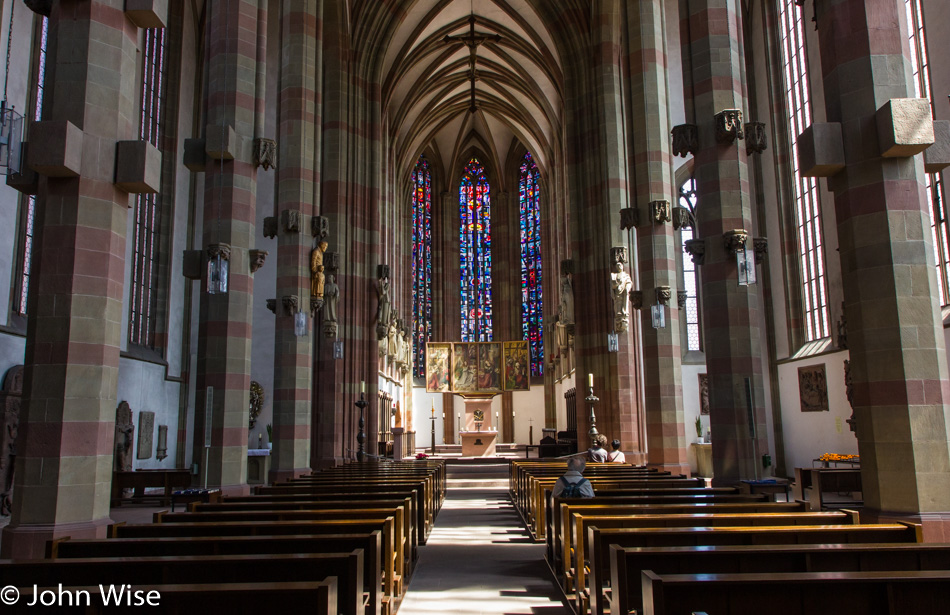
The 14th-century Gothic style looks good for its age.

How Caroline pulled this face while being attacked by this giant street shrimp, or is it a lobster? I’ll never know. That she’s letting me post her looking so goofy is wonderful, as it certainly makes me laugh.
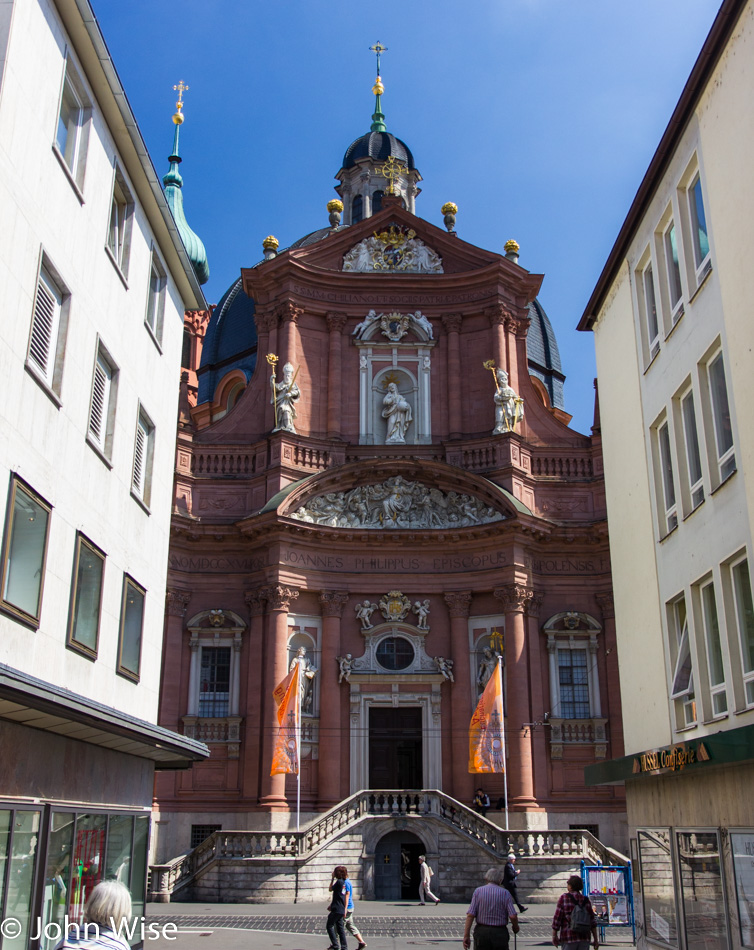
Then there was this church from 1065 called the Neumünster or New Munster church.

You’ve just got to love these baroque churches for the extravagance and crazy detail.

Just a simple shrine to the Virgin Mary. We have one just like it at home.

I’m a bit confused by skeletons as decoration for churches as I can’t help but think that death awaits you. While on a certain level, death awaits us all, I was raised to feel that the church uplifted you and helped you celebrate life, but who knows how people saw things 1000 years ago?
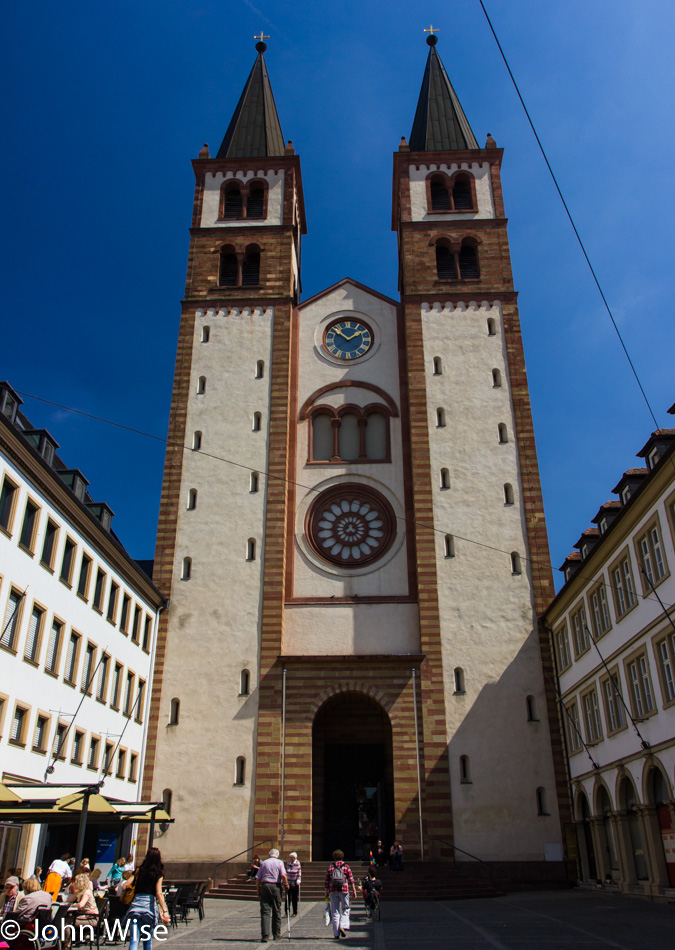
As we bounce from church to church, defiling these places of worship with our unbelieving souls, we wait for the person who might notice our evil atheist auras and toss some holy water on us, but sadly, this never happens. I also don’t really believe we’re evil, and I’d also wager that most visitors to these historic houses of God are tourists just like us. This church here is the St. Kilian Cathedral also known as Würzburger Cathedral.
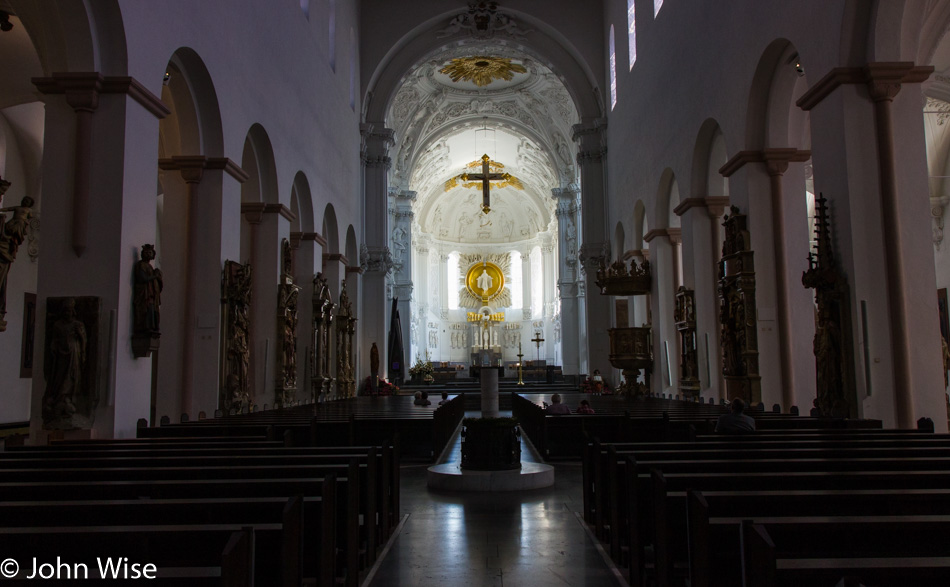
If you made it this far in my blog entry, maybe you are wondering if I’ll get serious and share anything really meaningful about observations or history lessons taken from this fourth day of our little road trip: nope. I’m kind of finished writing here and wish I’d not chosen so many damn pictures that I need to write to. Sure, Caroline has said, “Hey, you don’t need to write something under every photo.” but my OCD says, “OH YES, you do!”

Have you ever stood somewhere like this and wondered how many shades of gray are you actually looking at? Is there a function in Photoshop that can offer this information?
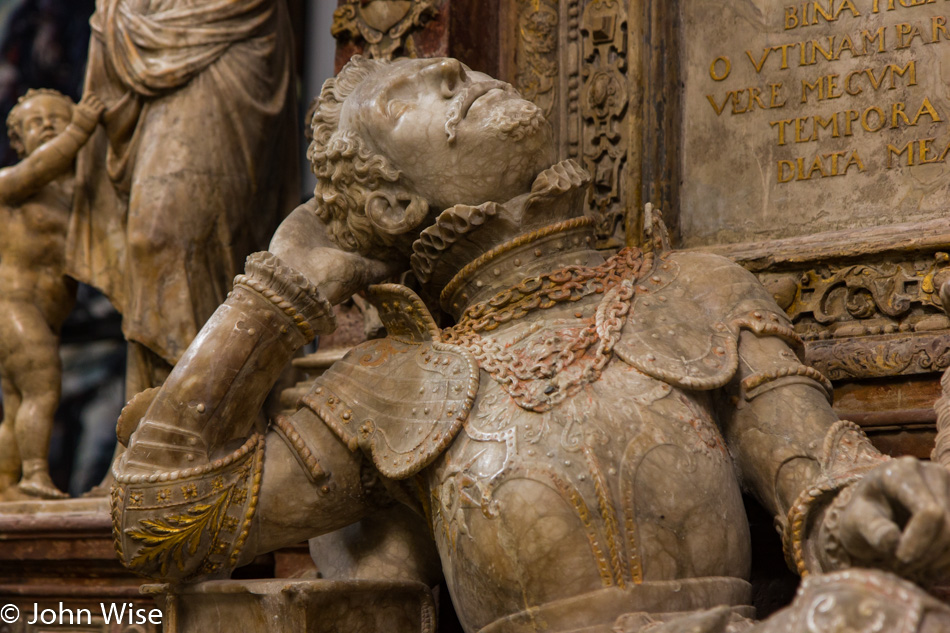
This is just how I look when I’m contemplating those kinds of questions, seriously, just like this, including the suit of armor and chains.
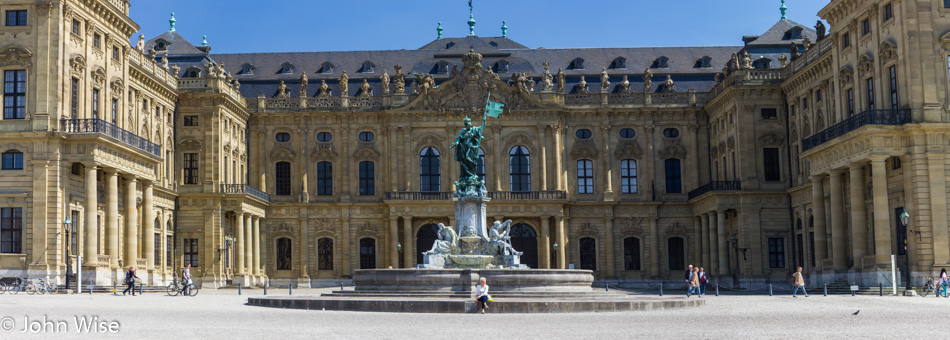
This is the Würzburg Residence, and we would have gone in, but there are warnings at the ticket counter of the risk of your head exploding due to the intricate, ornate, even flamboyant nature of the Baroque excesses that exist in this building. Having already visited two gothic and two baroque churches today, we felt this could easily tilt us into ecstatic overload and have put it off to a future visit. If you don’t believe me, just Google “Interior Würzburg Residence.”
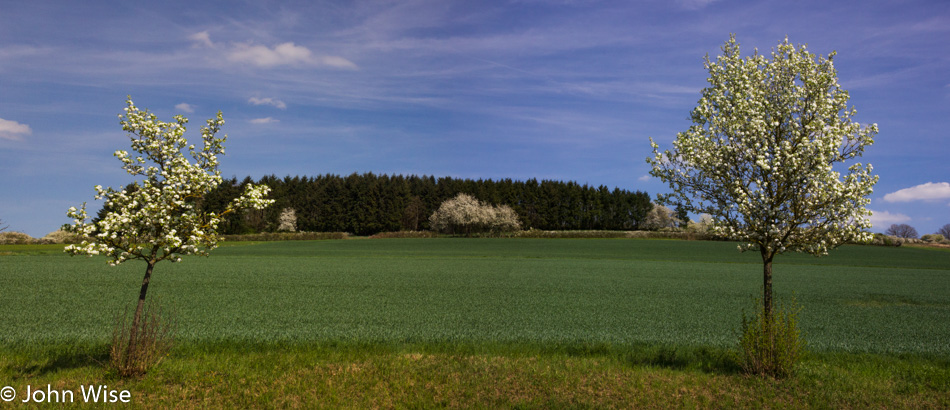
Just a couple of plain trees with a plain old field of grass in front of a plain stand of trees. Soothing simplicity for the baroque strained eyes needing a break.
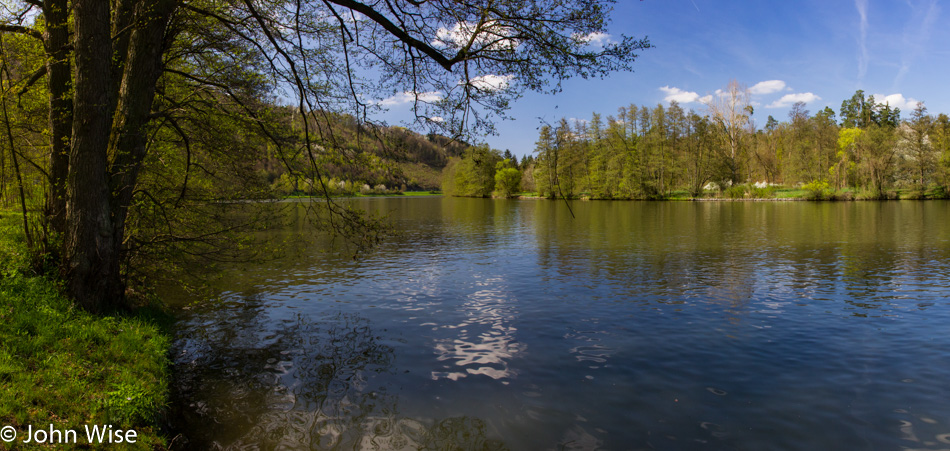
More of the above but with water.
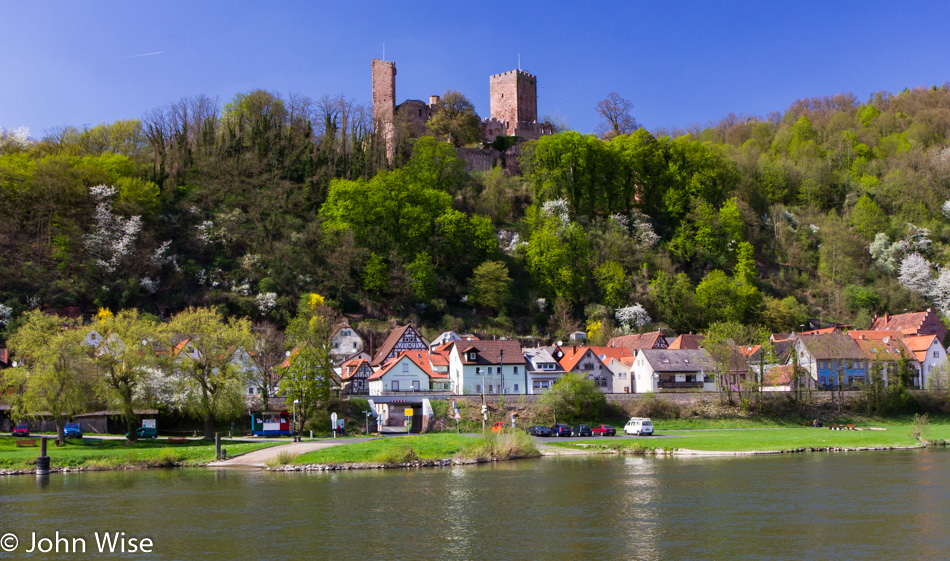
The view of Mondfeld on the Main River. We are traveling west, trying to maximize our sightseeing time.

And a quick stop in Miltenberg because the gate looks cool, so there might be other cool stuff here, and we’re hungry for some snacky stuff.

Fairytale-style is normal stuff all over Germany. I think I could spend 15 years just traveling to every small town and village in Europe and forever continue finding little treasures.

We left the Main River and continued west as Caroline said that the small town of Michelstadt had fond memories for her, so we went.

This is one of those days that just kept on going where we still had enough time to drop in on Jutta to check on her recovery from the broken hip. She’s doing great and is walking outside with us; seems that she’ll be just fine. I don’t know if I said it anywhere else here during our stay in Europe, but we tried to incentivize my mother-in-law by telling her that if she worked hard on her recovery, we’d have her visit us in America again as soon as she felt fit enough. So on November 2oth, she landed in Denver, Colorado which was the closest non-stop flight I could get her from Frankfurt to somewhere near Phoenix, Arizona, and she and I drove back to Arizona. Jutta stayed with us for 46 days, and sadly, it was her last visit to America as mobility and health had finally determined that it was best for her to stay close to home.

With Jutta happy to have seen us and heard briefly about our whirlwind adventure, we went over to our favorite pizza place in the entire universe called Olbia Pizzeria on Glauburgstrasse and shared a pizza.
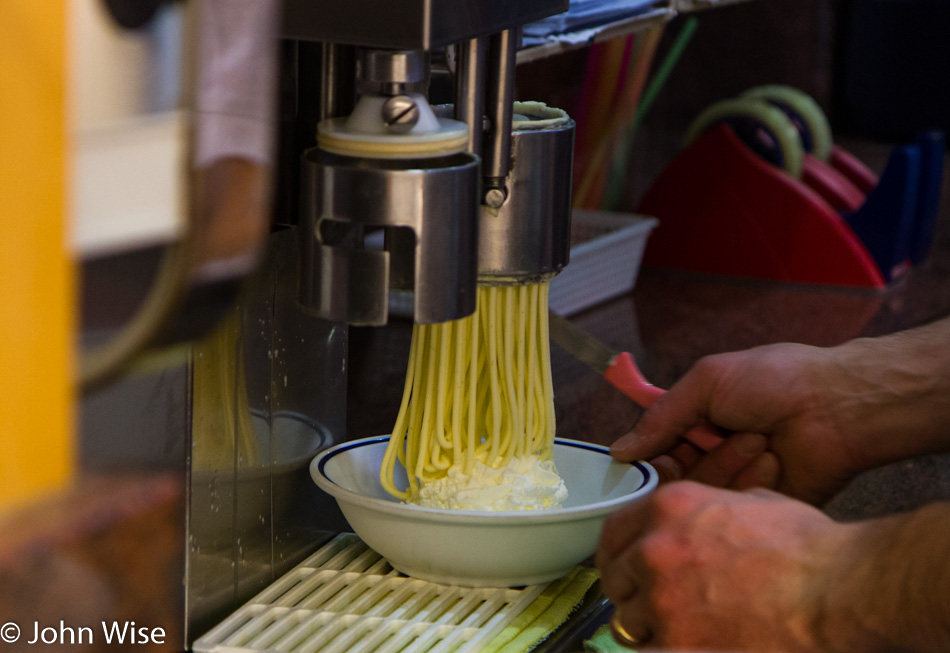
Being in our old neighborhood and running out of time in Frankfurt, we had to hit Eis Christina next, for you know what…

Sweet Jesus. It took 2500 words and a ton of photos to get to this moment where the famous Spaghetti Eis of our favorite ice-cream shop in the entire universe makes an appearance. If we could live on this and not kill ourselves with diabetes and obesity, we’d eat Spaghetti Eis three or four times a day.
I’d like to point out that these kinds of travels are, in some ways, just like eating the yummiest ice cream all the time; they are that incredible.